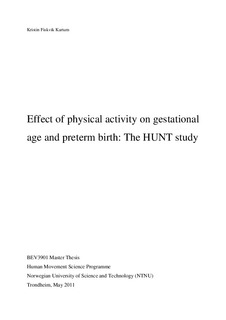| dc.description.abstract | Background The level of physical activity (PA) in the general population is considered too low, and this has also been shown for pregnant women. Although recent research has shown that regular moderate PA may be beneficial both for the mother and the fetus in relation to complications during pregnancy, the effect of being physically active before and during pregnancy is still debated.
Objectives The aim of this study is to examine the effect of PA before and during pregnancy in relation to mean gestational age and risk of preterm birth in a large cohort of women.
Subjects The study included a total of 2,515 women in HUNT 1 and 2,921 women in HUNT 2 aged between 20 and 35 years at the time of participation, and who had given birth during the following 5 years after the HUNT study.
Methods Gestational age obtained from The Medical Birth Registry of Norway. In HUNT 1, PA was reported as frequency, intensity and duration, and in HUNT 2, hours of light and hard PA per week was reported. For both studies a summary score combining information from the separate items was constructed, classifying participants into the following groups: No, light, medium, or high activity. Using linear regression to calculate adjusted mean differences in gestational length between the activity groups, and logistic regression to calculate adjusted odds ratios (ORs) as estimates of relative risk of preterm birth (gestational age <37 weeks). A 95% confidence interval (CI) was calculated to indicate the precision of the estimated associations.
Results PA before pregnancy was not related to mean gestational age, whereas for PA reported during pregnancy; inactive women had a non-significant 5.9 days (95% CI 2.2-13.9) shorter gestational length than active women. A similar pattern was evident for the risk of preterm birth; PA before pregnancy did not affect the risk of preterm birth. For PA during pregnancy there was a tendency that women who reported any level of activity had a lower risk of preterm birth compared with inactive women. The adjusted OR for women with low PA level was 0.26 (95% CI, 0.05-1.35), for those with medium PA level 0.46 (95% CI, 0.10-2.13), and for those with high PA 0.29 (95% CI, 0.04-2.05), all compared to the inactive.
Conclusion PA before pregnancy does not seem to affect either mean gestational age or the risk of preterm birth, whereas there were some evidence that being physically active during pregnancy, at a level above inactivity, may reduce the risk of preterm birth.
Keyword Physical activity • preterm birth • gestational age • pregnancy | nb_NO |
